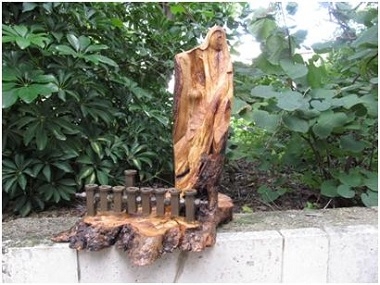Chanukah Light unto the Past and Present
Hewn from white Jerusalem stone, an impressive memorial to the children who perished in the Holocaust is situated a few meters from the home of kibbutz born and raised sculptor and collector of Judaica, Aviram Paz.
Having taken a particularly heart-wrenching feature from the late 1940's created Shoah memorial - a desperate mother trying to protect her terrified child – Paz has sculpted from a large chunk of olive wood a very special, poignant chanukiah for the Festival of Lights celebrations.
The eight hand forged chunky iron candle holders placed at the mother and child's feet are representative of the fire and smoke emanating from the crematorium chimney stacks, emphasizing the connection between the celebration of the miracle of Chanukah and the devastation but also survival of European Jewry from Hitler, the Nazis and their henchmen.
Completed in 1946, the memorial to the children who died in the Holocaust was created by Polish born Zeev Ben-Zvi who emigrated to British Mandatory Palestine in 1923, studied at Bezalel School of Art and in the 1930's taught there. Prior to his creating, with the help of then high-school students living in the close-by Shomria high-school at Kibbutz Mishmar HaEmek, Ben-Zvi had spent time teaching art to Holocaust survivors held in a displaced persons camps in Cyprus.
Apart from painting and sculpting, the detainees were also encouraged to make puppets, build models of the ships they had sailed in toward Palestine when trying to run the British Mandatory gauntlet, as well as models of their former towns and villages as they remembered them before the Holocaust.
As Jewish holidays the likes of Chanukah approached, they created Chanukiot and dreidels from the scarce wood and paper available in the camps and also used 'appropriated' biscuit tins scavenged from British soldiers serving there. A collection of such items can be found at Yad Yaari in Givat Haviva. Yad Yaari is a research and documentation center established to preserve and promote the intellectual assets of two key movements in Israel's history: Hashomer Hatzair, the first Zionist youth movement founded in 1911, and Kibbutz HaArtzi – a federation of 85 kibbutzim throughout Israel founded in 1927 and in present times part of the 273 member United Kibbutz Movement.
Emissaries from the Hashomer Hatzair and other Zionist movements were sent from Israel to the end-of-war created displaced persons camps on Cyprus as well as throughout Europe to help run cultural and educational activities for the refugees. When eventually released former detainees brought some of their creations with them to Israel, some of which found their way to the Yad Yaari archives at Givat Haviva.
Zeev Ben-Zvi wanted his memorial to the children who did not survive the Holocaust to be created near a school and that school-children be involved physically in its creation. Kibbutz Mishmar HaEmek agreed to house and feed the artist whilst he worked on the site next to the Shomria school for what became the first Holocaust memorial to be created in Israel.
The imposing, almost proud but solitary figure of the mother, with extraordinarily long arms, and child, arms upstretched toward the mother, towers over other children sculpted into the memorial. One small figure is totally separate from the others, squashed into a tiny space, almost in fetal position and representing those who were hidden and survived. Another panel shows children lining up, seemingly disappearing one into the other, as they are led to their deaths in the concentration camps.
When Zeev Ben-Zvi, whose memorial is called 'Pinat HaGolah' (the Diaspora Corner), began to create the memorial, the magnitude of the Holocaust was still not fully understood in Israel. News of the Warsaw Ghetto Uprising further propelled the Israel Prize winning sculptor into artistic action to memorialize those from his native Europe, with special focus on the children, who had been murdered.
The death of one Warsaw Ghetto Uprising fighter particularly affected Ben-Zvi and he incorporated a line from an encoded message sent out from the ghetto by her and is engraved on a wall in the basin of the Diaspora Corner. Tosia Altman was a member of the Hashomer Hatzair movement and comprehending the hopelessness of situation and impending fate, Tosia wrote an impassioned message on the 7th April, 1942.
"Israel is dying before my eyes and my arms are too short to help," she had penned. Ben-Zvi took her words to mean that her arms were not long enough to reach out and live her dream of joining her fellow Zionist movement members who had already made it to Israel – and therefore gave his anguished mother hewn from Jerusalem stone, much longer arms in an attempt to give her a better chance to protect, comfort, her offspring.
"I incorporated the horror of the Holocaust in this Chanukiah in order to honor the survivors of Hitler and the Nazis. They miraculously built new lives wherever they settled and were able to celebrate Chanukah with their own children and grandchildren, thus connecting the miracle of their survival from oppression and intended annihilation to that of the survival of the Jews thousands of years beforehand," explained Aviram Paz. He was holding his very special Chanukiah by the statue of the mother and child sculpted by Zeev Ben-Zvi. It is situated 20 or so paces from Aviram's kibbutz abode and the buildings of the still active Shomria high school where his late father Uzi Paz, he and his children, had also lived and studied.
Nes gadol haya poh - A great miracle happened here.










Comments